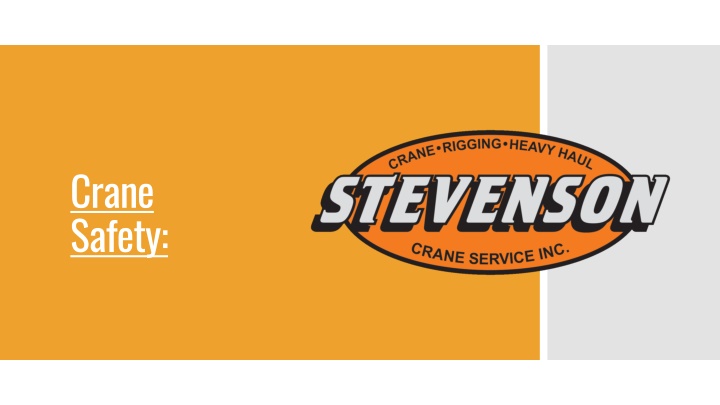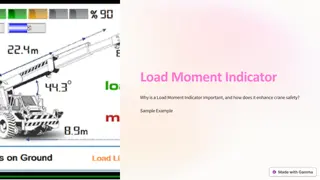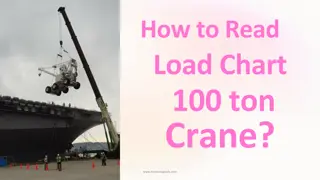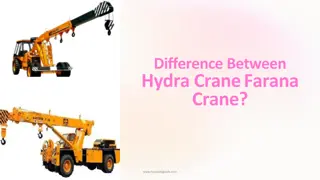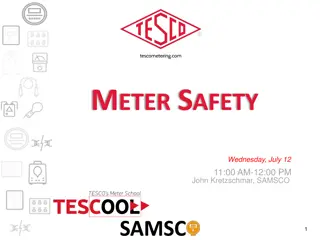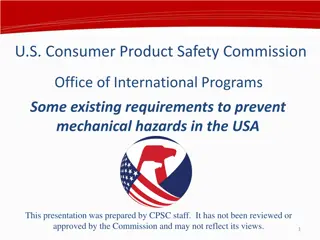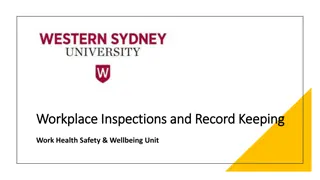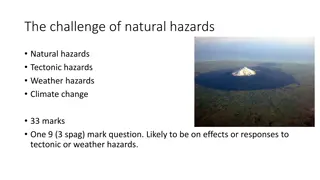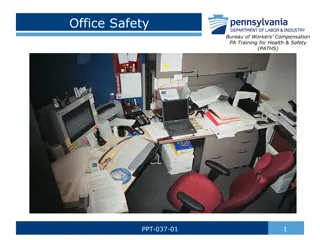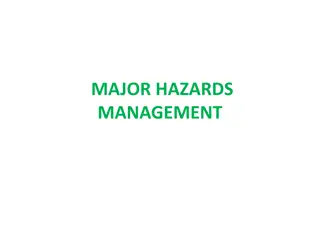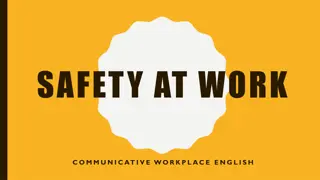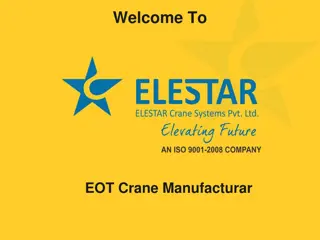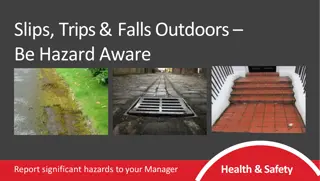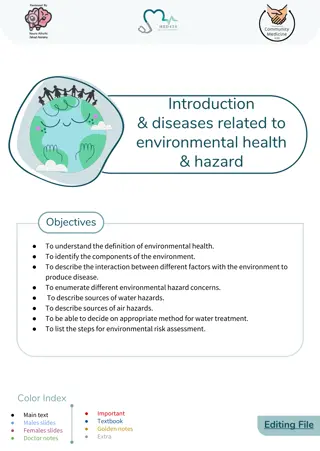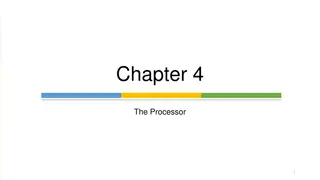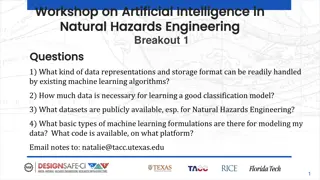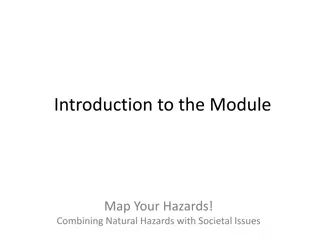Essential Crane Safety Training and Hazards Awareness
This training covers various hazards associated with crane use, OSHA standards, inspection guidelines, and common issues like electrical hazards, overloading, and poor weight distribution. The content emphasizes the importance of maintaining crane safety to prevent accidents, injuries, and damage to property and the environment.
Download Presentation

Please find below an Image/Link to download the presentation.
The content on the website is provided AS IS for your information and personal use only. It may not be sold, licensed, or shared on other websites without obtaining consent from the author.If you encounter any issues during the download, it is possible that the publisher has removed the file from their server.
You are allowed to download the files provided on this website for personal or commercial use, subject to the condition that they are used lawfully. All files are the property of their respective owners.
The content on the website is provided AS IS for your information and personal use only. It may not be sold, licensed, or shared on other websites without obtaining consent from the author.
E N D
Presentation Transcript
Crane Safety:
1. To inform operators of the various hazards associated with crane use. Objectives of Training: 2. To inform operators of the OSHA standards associated with safely operating equipment. 3. To inform operators about the proper times to conduct inspections, and the associated hazards they are based on.
Common Issues and Hazards with Cranes: [Workplace Lifting Safety Training] Retrieved from: https://youtu.be/LviUp94t65Q
Hazards: Common Issues and Hazards with Cranes: Electrical hazards, power lines. Overloading, poor weight distribution. Materials slipping or falling from the crane. Improper ground conditions.
Hazards cont. Power line example: This is a crane accident involving power lines that the crane or load did not come into contact with. Many Crane accidents result from improper clearance with overhead power lines. [Crane and powerline hazard] retrieved from https://www.youtube.com/watch?v= pwftUYkOX0Y
Common Issues: Overloading: [Overloading, Sims Crane Minute] Retrieved from: https://www.forconstructionpros.com/rental/lifting- equipment/crane/video/11148502/video-crane-overloading-is-not-safe
Damage to people and property: MATERIALS SLIPPING AND FALLING FROM THE CRANE IS A SERIOUS HAZARD BECAUSE PEOPLE UNDERNEATH THE CRANE OR AROUND THE WORKSITE CAN BE CRUSHED BY THESE OBJECTS, AND DAMAGE TO PROPERTY AS WELL AS PEOPLE GETTING HURT ARE ALSO SERIOUS HAZARDS. IT IS ALSO A HAZARD TO THE ENVIRONMENT AROUND THE CRANE. STEAM LINES, UNDERGROUND VAULTS, VOIDS, AND UTILITIES ARE ALL IMPROPER GROUND CONDITIONS.
Issues: Common Maintenance Hazards with Cranes: Damage and degradation to the wire rope. Alignment issues. Wear and tear on end truck wheels. Issues with electrification system. Bent or damaged hooks.
[Poor alignment] retrieved from: https://www.mazzellacompanies.com/re sources/blog/5-common-problems-with- overhead-cranes-and-how-to-avoid- them Common Maintenance Hazards with Cranes: [Bent and damaged hook] retrieved from: https://www.hoistandcranede pot.com/about-rigging-hook- safety-types-and-uses/ [Wear and tear on wire] retrieved from: https://www.mazzellacompanies.com/ Resources/Blog/how-to-inspect-wire- rope-slings-to-asme-b309-standards
Overhead Power Lines Insure there is a 20 foot clearance from the maximum work zone. If the work zone is closer than 20 feet to the load lines, then options 1, 2, or 3 are to be met. De-energize the lines and ensure they are grounded; Employer must ensure that the equipment, load lines, or load never get closer than the 20 foot clearance when operating; When maximum work zone is closer than 20 feet to power lines, Table A clearances are to be used. 1. 2. Corrective Measures: 3. [Table A from OSHA Power Line Safety] retrieved from: https://www.osha.gov/laws-regs/regulations/standardnumber/1926/1926.1408
Overhead Power Lines Cont. Corrective Measures involving power lines: When using Options 2 or 3, special encroachment precautions are to be met: A meeting with the operator and other workers in the area to review the location of the power lines. Steps to be implemented to prevent encroachment/electrocution. If tag lines are used, they must be non-conductive. High-visibility markers are to be placed at the 20 foot line (or otherwise specified in Table A) and if the operator can not see the markers, a dedicated spotter must be used. Either a proximity alarm or a dedicated spotter in constant contact with the operator must be implemented. No part of the equipment, load line, or load is to be under the power line unless employer has confirmed that the lines are deenergized.
Overloading / Poor Weight Distribution / Load Slipping or Falling Most modern cranes have overload protection systems. Earlier models may have 4 types of switches that when a load exceeds a certain limit, the crane will only be able to be lowered. The 4 types are the following: Mechanical. Electric. Mechanical/Electrical Hybrid. Chain Hoist. When first rigging a load, the load should only be hoisted a few inches above the ground then checked for proper balance and insurance that the load is completely secured. Verifying the rigging should insure that the load will not slip or fall. Corrective Measures:
When setting up the crane to pick up the desired load, it is crucial to investigate the weather conditions for the area, are right for safe crane operation. Weather: The most important weather conditions to keep in mind are the wind speed, and lightning. Just remember that high winds = uncontrollable load which makes the job unsafe for everyone. The crane arm also acts like a lightning rod.
When setting up the crane prior to operating, the following must be ensured: Crane Setup Hazards: The ground is level, and free from any obstructions. All outriggers are properly extended and the correct outrigger pads are used. When checking the outriggers, there should be nofloat. The crane s area is large enough to satisfy the crane s radii when rotated.
Crane Outrigger Setup: [Proper outrigger utilization] retrieved from: https://stevensoncrane.com/p roduct/maeda-mc-405-c/ [Improper outrigger utilization] retrieved from: https://www.cranetech.co m/blog/leveling-the-field/
When extending the outriggers of the crane and also when placing the pads in the desired area, be sure to follow all safety rules. Hazards that are associated with this are as follows: Crane Extending the outriggers into a person or piece of equipment. Pinch points when setting up the outriggers pads. Ensure proper pads are used to reduce the risk of an outrigger leg slipping off the pad. Outrigger Hazards: Note: Proper pad placement and proper type of pad will greatly reduce the risk of the crane tipping over.
Crane Outrigger Pads - Correct Use: The image shown is the correct utilization of the outrigger pads. Note that the outrigger legs are centered directly in the middle of the pad. Image retrieved from https://dicausa.com/fibermax-crane-pads/
Crane Outrigger Pads - Incorrect Use: The image shown here is the incorrect use of wood blocks. There should be no gaps between the blocks and the ground should be level. Image retrieved from http://www.elcosh.org/document/148 8/748/d000104/selection.html
OSHA Standard for Outrigger Use: OSHA Standard 1910.180(h)(3)(ix) states: Outriggers shall be used when the load to be handled at that particular radius exceeds the rated load without outriggers as given by the manufacturer for that crane. Where floats are used they shall be securely attached to the outriggers.
To reduce the risk of crane failure, inspections on each component of the crane is required. Crane Inspections and Associated Hazards: Periodic or frequent are two crane usage classifications that determine the inspection intervals. OSHA defines the intervals as: Frequent inspection -daily to monthly intervals. Periodic inspection -1 to 12 month intervals or as specified by manufacturer.
OSHA 1926.1412 (c) After completion of assembly, the equipment must be inspected by a qualified person to ensure it meets manufacture criteria. Post (2)(i) Determine is a registered professional engineer (RPE) is familiar with the specific type of equipment needs to develop criteria for the equipment configuration. If the RPE is not needed, employer must ensure it is developed by a qualified person. Assembly inspection: (c)(3) Equipment must not be used until an inspection under this paragraph demonstrates equipment is configured in accordance with criteria.
1926.1412(g) - 1926.1412(g)(3) Under conditions where significant damage via overloading, shock loading, or continuous usage in a corrosive environment, the crane must be brought down for mandatory inspection. A qualified person must determine if the equipment is still safe to use, and make sure it satisfies the criteria listed under 1926.1412(f). If an issue is discovered, the employer is required to satisfy the requirements found under 1926.1412(f)(4)-1926.1412(f)(6). Severe Service Environment Inspections:
OSHA 1910.1809(d)(3) explains frequent inspection as: "Frequent inspection." Items such as the following shall be inspected for defects at intervals as defined in paragraph (d)(2)(i) of this section or as specifically indicated including observation during operation for any defects which might appear between regular inspections. Any deficiencies such as listed shall be carefully examined and determination made as to whether they constitute a safety hazard Crane Inspections and 1926.1412 (2)- If there are any deficiencies in inspection are found, a determination by a competent person must be made to decide if it is a safety hazard. If it is a safety hazard then equipment must be taken out of service until it is corrected. 1926.1412 (3)- If any deficiencies are found then action must be taken prior to using equipment. Associated Hazards:
Crane Inspections and Associated Hazards: OSHA 1926.1412 (d) (i)-(d) (xiv) (i) Control mechanisms interfering with operation. (ii) Control and drive mechanics with excessive wear and contamination by lubricants and other foreign matter. (iii) Air, Hydraulic and other pressurized systems for deterioration or leakage. (iv) Hydraulic system for proper fluid levels. (v) Hooks and latches for: deformation, cracks, excessive wear, or chemical damage. (vi) Wire rope in compliance with manufacturer. (vii) wire rope in accordance with 1926.1413 . (viii) Electrical apparatus for: malfunctioning, deterioration, dirt, and moisture accumulation.
Crane (ix) Tires for proper inflation and condition. (x) Ground conditions around equipment for support: ground settling under and around outriggers/stabilizers, and foundations, groundwater accumulation, does not include railroad tracks. (xi) equipment for level position specified by manufacturers recommendation, both before and after each shift. (xii) Operator cab windows for: significant cracks, breaks or other deficiencies that can hinder operators view. (xiii) When equipment is rail traveling: Rails, Rail stops, and Rail clamps. (xiv) Safety devices and operational aids for proper operation. Inspections and Associated Hazards continued:
A crane inspection must be performed prior to operating the crane. Any deficiencies located must be taken care of before the crane can be safely operated. Crane Inspection Checklist: Refer to OSHA 1926.1412(d)(2) and (3). Image retrieved from: https://store.craneinstitute.co m/products/inspection-checklist- tower-crane-annual-periodic
Operators of derricks, sideboom cranes, or equipment with a maximum manufacturer- rated hoisting/lifting capacity of 2,000 lbs. or less are not required to be certified/licensed but still must complete training. An employee that is not certified/licensed may work as an operator-in-training only under supervision. An operator-in-training may not operator if any of the following circumstances; If the work zone is closer than 20 feet of a power line up to 350kV, or within 50 feet of a power line over 350kV. The equipment is being used to hoist personnel. Multiple-equipment lifts. If the equipment is used over a shaft, cofferdam, or in a tank farm. Crane Operator Qualification:
Audited Employer Program: The employers certification of its employee must meet the following requirements Written and practical tests must be either; The employer program must be audited within 3 months of the beginning of the program and at least every 3 years thereafter. Developed by an accredited crane operator organization. Approved by an auditor. Crane Operator Qualification: Certification is achieved when a written test is passed on all the knowledge as skills needed to operate equipment safely. The employer must ensure that each operator is qualified through an evaluation of skills and knowledge necessary to operate the equipment safely.
References: CraneOperations.jpg. (n.d.). Retrieved November 26, 2019, from https://ehs.princeton.edu/workplace-construction/workplace-safety/construction- safety/crane-safety/crane-operations. Department of Labor logo UNITED STATESDEPARTMENT OF LABOR. (n.d.). Retrieved November 26, 2019, from https://www.osha.gov/laws- regs/regulations/standardnumber/1926/1926.1412. Lang, J. (n.d.). How do overload protective devices work? Retrieved from https://www.konecranesusa.com/resources/lifting-viewpoints/how-do-overload-protective- devices-work. Managing Mobile Crane Hazards. (n.d.).Retrieved November 26, 2019, from http://www.elcosh.org/document/1488/745/d000104/hazards.html.
References: Operator training, certification, and evaluation. (2018, November 9). Retrieved from https://www.osha.gov/laws-regs/regulations/standardnumber/1926/1926.1427. Power line safety (up to 350 kV)--equipment operations.(2010, August 9). Retrieved from https://www.osha.gov/laws-regs/regulations/standardnumber/1926/1926.1408 UNITED STATES DEPARTMENT OF LABOR. (n.d.). Retrieved November 26, 2019, from https://www.osha.gov/SLTC/cranehoistsafety/hazards.html. Video: Crane Overloading is not Safe. (n.d.). Retrieved November 26, 2019, from https://www.forconstructionpros.com/rental/lifting-equipment/crane/video/11148502/video- crane-overloading-is-not-safe.
